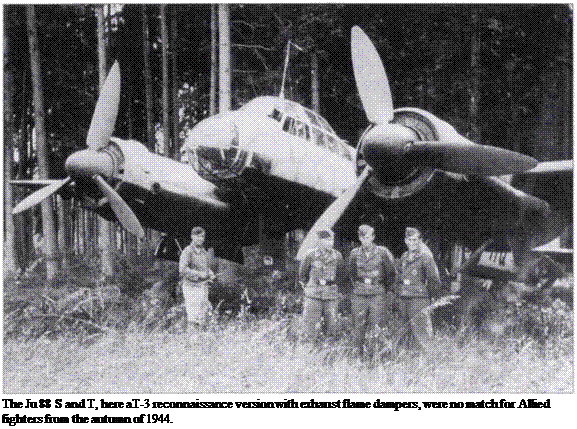On the Road to the Abyss
|
T |
he coming collapse of the Luftwaffe could be seen relatively early, although at the highest level, in particular for Reichsmarschall Goring, this was not accepted. After the disaster at Stalingrad, the overall war situation deteriorated and with it the general situation for the Luftwaffe. Offensive capacity declined as a result of the heavy losses over the Eastern Front and the aircrew losses sustained during the attempts to supply encircled troop conglomerations. During the fighting in the East and Italy, the Allies found it increasingly easy to win territory and so force the Wehrmacht completely to the defensive.
From the summer of 1943, the US Eighth Air Force demonstrated that the Allies could successfully attack important ground targets everywhere in Europe with high precision even by day and in unprecedented numbers. RAF four- engined bombers attacked one major German city after another, mosdy by night, their purpose being to demoralise the German people, particularly the labour force, and bring about the greatest possible war weariness in the medium term.
The increased use of long-range escort fighters and ever better protected four – engined bombers such as the B-17 and B-24 was decisive for the course of the air war. In this way the Allies forced the squadrons of the once ‘invincible’ Luftwaffe step by step onto the defensive, even over Reich home territory. The fire storm at Hamburg showed the Luftwaffe leadership the strength of the enemy against which it was pitted, and more and more towns disintegrated into ash and rubble. The beginning of the end had been reached.
As 1944 dawned, large enemy bomber formations were attacking the production centres of the German aviation industry even by day. Heavy bomb- loads were dropped on shipyards, power stations and above all fuel refineries so important for a war effort in which all had been wagered on mechanisation. Nevertheless the number of completed fighters still rose noticeably. The monthly increase in production from 1,000 to 3,000 single-engined machines was intended eventually to force the Western Allies to abandon their bombing policy.
Aircraft Production Programmes 223 and 224 had this aim but increased production of fighters was not possible at once. One difficult problem was the
 |
shortage of aluminium and other necessary raw materials for aircraft manufacture. Fuel production and the adequate training of aircrews also declined from 1944. The decrease in training flights was proportional to the lack of operational successes experienced later. An infrastructure disintegrating under constant bombing and a gradual flattening out of fuel production provided little prospect of cheer from mid-1944. Lines of communication, particularly the railways, were the constant target of air raids and low-level attacks, while attacks on inland shipping and other traffic, especially in the West, ensured delays to raw materials and other supplies.
Operation Steinbock, the resumption of the bombing offensive in the West, proved little more than a flash in the pan over England. In comparison, the evergrowing enemy air forces were so superior that they could strike with great precision wherever and whenever they chose. On account of the shortened training schedules, losses during tactical training rose. This was partly due to the lack of flying instructors and training aircraft with dual controls. In the summer of 1944 the training period of Luftwaffe fighter pilots was only 35 per cent of
its former length, and the training units also faced severe shortages of fuel. Pilots newly operational were often referred to as ‘three-day wonders’ by veterans because so many failed to survive their first sorties.
The massive delays which occurred before the large-scale introduction of jets, and the numerous related technical hitches, spawned serious doubts in the possibility of final victory. The advent of a miracle weapon was a factor even amongst a section of the Reich government which provided hope for a favourable change in the situation, and became important in evaluating the military situation to the very end.










